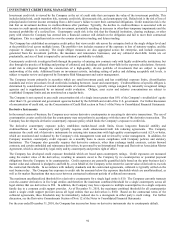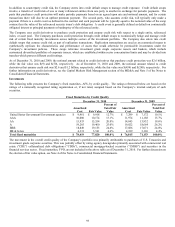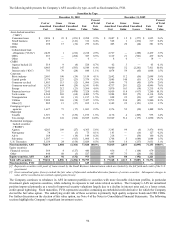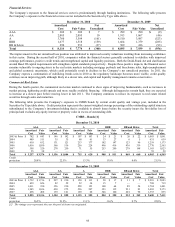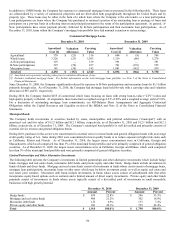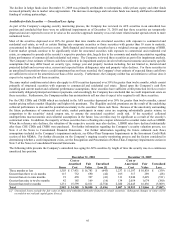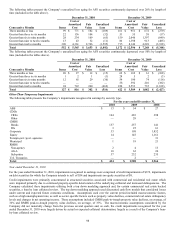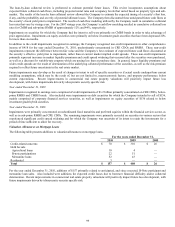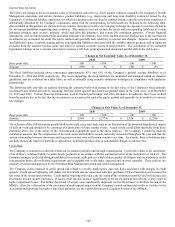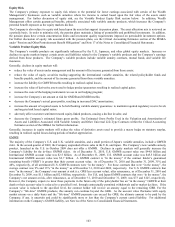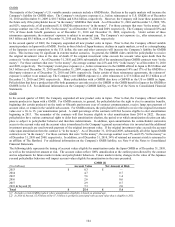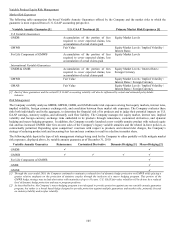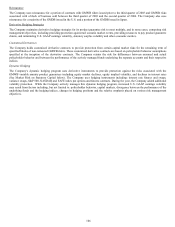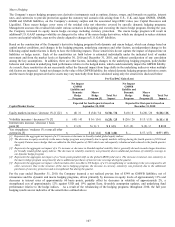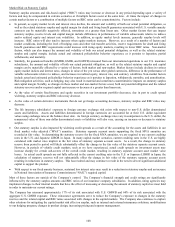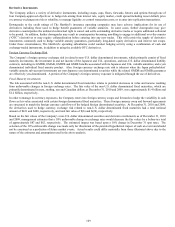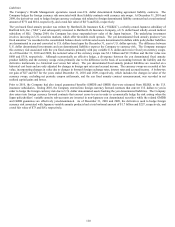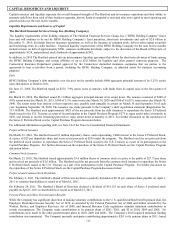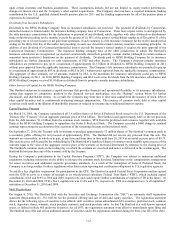The Hartford 2010 Annual Report Download - page 102
Download and view the complete annual report
Please find page 102 of the 2010 The Hartford annual report below. You can navigate through the pages in the report by either clicking on the pages listed below, or by using the keyword search tool below to find specific information within the annual report.
102
Interest Rate Sensitivity
The before-tax change in the net economic value of investment contracts (e.g., fixed annuity contracts) issued by the Company’ s Wealth
Management operations and certain insurance product liabilities (e.g., short-term and long-term disability contracts) issued by the
Company’ s Commercial Markets operations, for which the payment rates are fixed at contract issuance and the investment experience is
substantially absorbed by the Company’ s operations, along with the corresponding invested assets are included in the following table.
Also included in this analysis are the interest rate sensitive derivatives used by the Company to hedge its exposure to interest rate risk in
the investment portfolios supporting these contracts. This analysis does not include the assets and corresponding liabilities of certain
insurance products such as auto, property, whole and term life insurance, and certain life contingent annuities. Certain financial
instruments, such as limited partnerships and other alternative investments, have been omitted from the analysis due to the fact that the
investments are accounted for under the equity method and generally lack sensitivity to interest rate changes. Separate account assets
and liabilities, equity securities, trading and the corresponding liabilities associated with the variable annuity products sold in Japan are
excluded from the analysis because gains and losses in separate accounts accrue to policyholders. The calculation of the estimated
hypothetical change in net economic value below assumes a 100 basis point upward and downward parallel shift in the yield curve.
Change in Net Economic Value As of December 31,
2010 2009
Basis point shift - 100 + 100 - 100 + 100
Amount $ (190) $ 96 $ (30) $ (9)
The fixed liabilities included above represented approximately 47% and 63% of the Company’ s general account liabilities as of
December 31, 2010 and 2009, respectively. The assets supporting the fixed liabilities are monitored and managed within set duration
guidelines, and are evaluated on a daily basis, as well as annually using scenario simulation techniques in compliance with regulatory
requirements.
The following table provides an analysis showing the estimated before-tax change in the fair value of the Company’ s fixed maturity
investments and related derivatives, assuming 100 basis point upward and downward parallel shifts in the yield curve as of December
31, 2010 and 2009. Certain financial instruments, such as limited partnerships and other alternative investments, have been omitted
from the analysis due to the fact that the investments are accounted for under the equity method and generally lack sensitivity to interest
rate changes.
Change in Fair Value As of December 31,
2010 2009
Basis point shift - 100 + 100 - 100 + 100
Amount $ 2,988 $ (2,774) $ 2,326 $ (2,230)
The selection of the 100 basis point parallel shift in the yield curve was made only as an illustration of the potential hypothetical impact
of such an event and should not be construed as a prediction of future market events. Actual results could differ materially from those
illustrated above due to the nature of the estimates and assumptions used in the above analysis. The Company’ s sensitivity analysis
calculation assumes that the composition of invested assets and liabilities remain materially consistent throughout the year and that the
current relationship between short-term and long-term interest rates will remain constant over time. As a result, these calculations may
not fully capture the impact of portfolio re-allocations, significant product sales or non-parallel changes in interest rates.
Credit Risk
The Company is exposed to credit risk within our investment portfolio and through counterparties. Credit risk relates to the uncertainty
of an obligor’ s continued ability to make timely payments in accordance with the contractual terms of the instrument or contract. The
Company manages credit risk through established investment credit policies which address quality of obligors and counterparties, credit
concentration limits, diversification requirements and acceptable risk levels under expected and stressed scenarios. These policies are
regularly reviewed and approved by the Enterprise Risk Management group and senior management.
The Company is also exposed to credit spread risk related to security market price and cash flows associated with changes in credit
spreads. Credit spread tightening will reduce net investment income associated with new purchases of fixed maturities and increase the
fair value of the investment portfolio. Credit spread widening will reduce the fair value of the investment portfolio and will increase net
investment income on new purchases. If issuer credit spreads increase significantly or for an extended period of time, it may result in
higher impairment losses. For further discussion of sectors most significantly impacted, see the Investment Credit Risk Section of the
MD&A. Also, for a discussion of the movement of credit spread impacts on the Company’ s statutory financial results as it relates to the
accounting and reporting for market value fixed annuities, see the Capital Resources & Liquidity Section of the MD&A.


